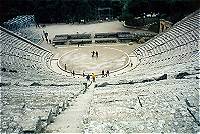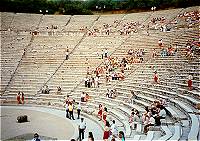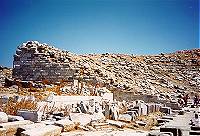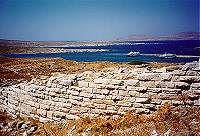
DR.
J'S ILLUSTRATED LECTURES
The
Illustrated Mythic Hero
Illustrated Greek Theater
Illustrated Greek Drama
Illustrated Parthenon Marbles
Illustrated Road to the Recovery of
Ancient Buildings
Illustrated Greek History MENU
Bronze Age
Archaic Age
Persian Wars
Classical Age
|
 |

Dr. J's
Illustrated Greek Theater
to
be read in conjunction with
Dr.
J's Illustrated Greek Drama
General
Design of a Greek Theater
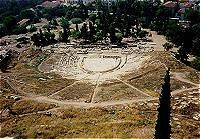 Like other significant civic
events such as assemblies and orations, the Greek theatrical
experience takes place outside in a prominently established site capable of holding
thousands of people. Up until about the time of Thespis, theatrical performances in honor
of Dionysus in Athens took place in the agora. But an accident that hurt spectators caused
the powers that be (the exact date is uncertain) to build a new theater (the
Theater of Dionysus in Athens,
photo left),
and a spot on the south slope of the Acropolis next to the already established Temple of
Dionysus Eleutherios was chosen. By the way, Eleutherios refers to the place in Boeotia
(Eleutherai) where the god first appeared in mainland Greece and where his cult worship
began. The Theater of Dionysus in Athens may have been the first theater, but the idea
caught on fast...as you can see from this selection of the 164 Greek theaters excavated in
Greece, there are 3 minimal requirements: they are all built into a hill, provide a
breathtaking view to the audience, and offer a flat performance area: Like other significant civic
events such as assemblies and orations, the Greek theatrical
experience takes place outside in a prominently established site capable of holding
thousands of people. Up until about the time of Thespis, theatrical performances in honor
of Dionysus in Athens took place in the agora. But an accident that hurt spectators caused
the powers that be (the exact date is uncertain) to build a new theater (the
Theater of Dionysus in Athens,
photo left),
and a spot on the south slope of the Acropolis next to the already established Temple of
Dionysus Eleutherios was chosen. By the way, Eleutherios refers to the place in Boeotia
(Eleutherai) where the god first appeared in mainland Greece and where his cult worship
began. The Theater of Dionysus in Athens may have been the first theater, but the idea
caught on fast...as you can see from this selection of the 164 Greek theaters excavated in
Greece, there are 3 minimal requirements: they are all built into a hill, provide a
breathtaking view to the audience, and offer a flat performance area:
|
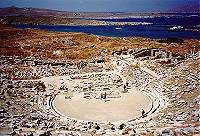 |
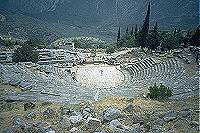 |
|
isle
of Delos |
Delphi |
The
Orchestra
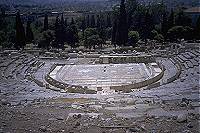 |
Even the most primitive of Greek
theaters had the most important of these elements: the orchestra, or
"dancing-place." It was in this circular area that the chorus, a group of 12-15
actors in a single unit, sang and danced. In the archaic Theater of Dionysus in
Athens (left),
the original orchestra floor was just smoothed dirt and was eventually replaced with
polished stone as the architecture of theater evolved. In the center of the orchestra
there was an altar to the god Dionysus where a flute player was stationed. |
|
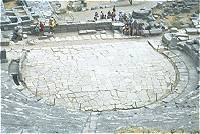 |
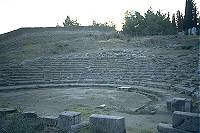 |
|
Delphi |
Chaironea |
The
Theatron
Classical
theater is all about spectacle. In Greek, theaomai means "to view" and theatai
were the people who viewed the performance, or the "spectators" in a theatron,
or "viewing area." Roman "auditorium," conversely, comes from the
Latin word audio, "to hear." Everyone in the Greek theater was assured
a clear view of the orchestra and the stage (there were no support pillars that could
block one's view) and since the theater is built into an already existing hill, the seats
are naturally arranged on an upward slope, assuring that each tier of seats is above the next. But even though the designing
focus was on a good viewing area, the Greek theater boasts magical acoustic properties as
well. A single individual's voice - or even the sound of a match being struck - rises
clearly to the uppermost seats, unless it is overpowered by a raucous chorus of
competing crickets, of course, a particularly vexing problem at Epidavros,
which is in a wooded setting. Below are two views of the orchestra from an excellent
vantage point (not the cheap seats!)
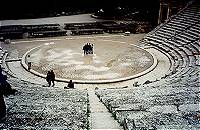 |
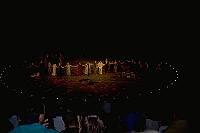 |
|
a
1996 practice session |
1998
performance of Sophocles' Electra at the Theater of Epidavros |
Some people, of
course, were given preferential treatment: most theaters (like Delos, below left, and
Athens, below right) have a row of specially designed seats nearest the orchestra for
dignitaries, judges and priests. The
Theater of Dionysus in Athens
even
has a Throne just for the officiating Priest of Dionysus. And boy, do I wish I had a
photographic record of the time the Greek Navy (in their dress whites!) was escorted into
the Theater of Epidavros and seated stage center, the best seats in the house. The entire
audience gave them a rousing standing ovation that lasted for minutes.
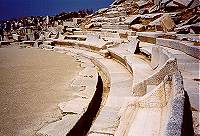 |
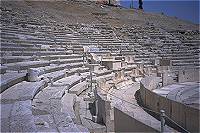 |
|
Delos |
Athens |
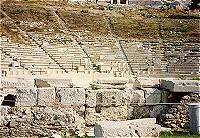 |
But
the rest of the 15,000 or so people who filled the theatron of a
classical theater got to their seats by climbing the stairwells made for
that purpose. In a typical theater, radial stairs divide the theatron
into kerkides, or wedge-shaped seating areas (left, Theater of
Dionysus, Athens). A walkway called a diazoma (below left,
Epidavros), divides the upper story of the theatron from the lower
portion closer to the orchestra. The diazoma
allows for a whole new arrangement of stairwells in the upper story: as
the seating area spreads wider, more stairs are necessary for safe and
comfortable access (below right, Epidavros). |
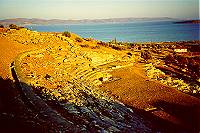 Like
the the theater in Epidavros, most
extant theaters date back only to Hellenistic Greece (3rd-2nd century BC), but the Archaic
theater in Thorikos (the American School for Classical Studies in Athens' first
excavation!), is the earliest stone theater in Greece, with parts dating to the 6th
century BC ... and it is not round: its cavea is rectangular. Is it Like
the the theater in Epidavros, most
extant theaters date back only to Hellenistic Greece (3rd-2nd century BC), but the Archaic
theater in Thorikos (the American School for Classical Studies in Athens' first
excavation!), is the earliest stone theater in Greece, with parts dating to the 6th
century BC ... and it is not round: its cavea is rectangular. Is it possible that round theaters were a later development? Thorikos' theater has only twostairways, which
divide the theatron into three sections: the central section is a nearly perfect
rectangle, while the two edge sections are curved in. The upper rows of the theatron were
accessed by stairways, and the corbelled archway over one ramp survives (photo on right).
possible that round theaters were a later development? Thorikos' theater has only twostairways, which
divide the theatron into three sections: the central section is a nearly perfect
rectangle, while the two edge sections are curved in. The upper rows of the theatron were
accessed by stairways, and the corbelled archway over one ramp survives (photo on right). |
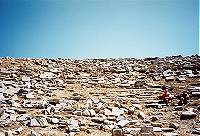
The
seating areas of most classical theaters
are not especially well-preserved (many of the
limestone blocks were carted away to be used as building materials in ages subsequent to
antiquity). For example, although the orchestra of the theater on Delos is in good shape,
the theatron is an almost unrecognizable mess of stone (photo on right). |
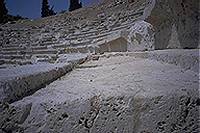 Although the
upper seats of the theater of Dionysus in Athens are all but gone, some of the lower seats
survive intact from the fourth century BC and show a superb attention to detail: the seats
are designed to allow 13 inches of foot room so that every spectator can sit comfortably
with his heels back (photo on left). Although the
upper seats of the theater of Dionysus in Athens are all but gone, some of the lower seats
survive intact from the fourth century BC and show a superb attention to detail: the seats
are designed to allow 13 inches of foot room so that every spectator can sit comfortably
with his heels back (photo on left). |
|
As the seating area of a theater
became enlarged, it became necessary to build supporting walls for the theatron called analemmata.
Shown below is the particularly well articulated analemma from the theater at Delos: |
The
Skene
One of the first
modifications to the basic performance area of archaic theaters was the addition of a
portable wooden stage area, which was later replaced with a more permanent design. By the
time of Aeschylus, the skene came complete with a painted (probably) facade representing
the power source of the play, usually a palace or temple. The backdrop also included a
door, through which actors could enter and exit the performance area. Murders and other
violent scenes were usually performed out of sight of the audience, "behind closed
doors." Therefore, classical theater often resorted to the use of a wheeled cart
called an ekkyklema to divulge the activity acted out "behind the
scenes." The most typical burdens of the ekkyklema was the corpse of a
murdered individual.
 The
circular pathway that surrounds the orchestra is called the parodos and can be
accessed from either side of the skene. The parodos is an important element of
the Greek theater and serves a double purpose: first, it provides the audience with a way
to access their seats. More importantly for the purpose of staging the play, though, it
provides access to the chorus and some actors to the orchestra. The chorus never entered
the orchestra from the skene, and some characters are denied access because they lack the
might and right to be associated with the power structure represented by the
skene:
messengers, visitors, exiles, etc (see mini-lecture below for an example of staging a
Greek play). It is not uncommon, however, for characters to move freely between the skene
and the orchestra. In the case of human beings, ramps or stairways serve their purpose,
but in the case of divine messengers or visitors, a mechane (crane) would lift
them bodily into the air. The
circular pathway that surrounds the orchestra is called the parodos and can be
accessed from either side of the skene. The parodos is an important element of
the Greek theater and serves a double purpose: first, it provides the audience with a way
to access their seats. More importantly for the purpose of staging the play, though, it
provides access to the chorus and some actors to the orchestra. The chorus never entered
the orchestra from the skene, and some characters are denied access because they lack the
might and right to be associated with the power structure represented by the
skene:
messengers, visitors, exiles, etc (see mini-lecture below for an example of staging a
Greek play). It is not uncommon, however, for characters to move freely between the skene
and the orchestra. In the case of human beings, ramps or stairways serve their purpose,
but in the case of divine messengers or visitors, a mechane (crane) would lift
them bodily into the air.
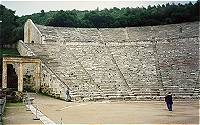
Eisodoi are
the ramps that give access to the paradoi, and the Romans were particularly fond
of creating elaborate stage areas. The archway in the photo on the left at Epidavros would
have covered the stage left eisodos. |
|
The Romans also
greatly elaborated upon the simple Greek skene itself. On the left is the little theater
at Oropos, with its accompanying Roman stoa, the sort which is usually two-storied and is
used as a storage area for scenery and props, as well as the actors' changing room. On the
right is the celebrated Bema of Phaedrus, a Roman addition to the theater of Dionysus in
Athens.
|
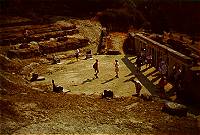 |
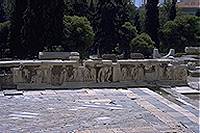 |
|
Oropos |
Athens |
The Staging of Play
The purpose of this section
is to prove the usefulness of knowing this information. Words in
blue were introduced in this lecture. It can
be helpful to know how the playwright would have used the different parts of the classical
theater to stage his play. The
orchestra was the chorus' domain; actors generally remained on the
skene
unless they entered the performance area through a
parodos directly onto the
orchestra. It is important to remember that the
skene represents the power source
in the play. Such knowledge can help to illuminate the underlying themes of a play. For
example:
In the Agamemnon, the
skene
is dressed to look like the Palace at Mycenae (Argos). Who enters the
performance area through the double doors of the
skene?
Clytemnestra. Who is in charge? Clytemnestra. Agamemnon, the King,
arrives home after the war, but enters directly into the
orchestra (via the
parodos)
in his chariot and joins the multitude outside the royal house, like any other citizen of
the city (represented by the chorus, already inhabiting that space) - this is a clear signal that he does not
hold the upper hand in his own house. He eventually does pass through the doors of the
skene - and the next time we see
him, he is being wheeled out through those doors again - a corpse on the
ekkyklema.
After the murders of
Cassandra and Agamemnon, Clytemnestra and Aegisthus make a final appearance, passing
through the double doors of the
skene one more time to appear before the people of Argos as their King and
Queen. A nice touch is that this scene is replayed in reverse in The Libation Bearers
- the second play of the trilogy - when it is Orestes who begins as a visitor in his own
home, is welcomed into the royal house through the door of the
skene, and then wheels the corpses of
Aegisthus and Clytemnestra out through the same double doors on the same
ekkyklema they used in the first play.
Tour theaters I don't have
pictures of!
Learn more about Greek
Stagecraft including the buildings, scenery, props and actors' masks.
See some great aerial views of
these theaters and others
|













